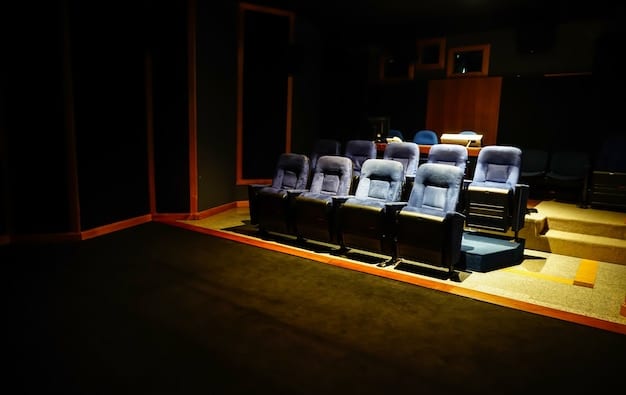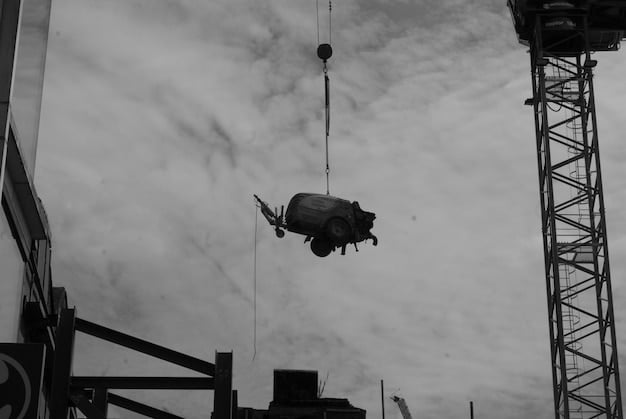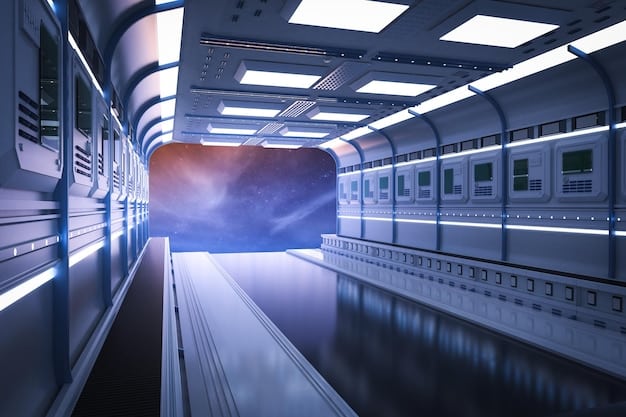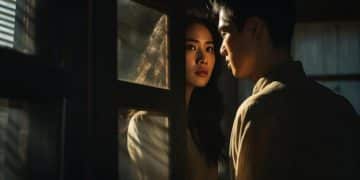The Power of Sound: Iconic Movie Scenes and Music’s Impact

The Power of Sound: Analyzing the Impact of Music in 3 Iconic Movie Scenes reveals how carefully chosen soundtracks amplify emotions, heighten drama, and leave a lasting impression on viewers, enhancing the storytelling process.
Dive into the captivating world where sound and cinema collide. This article, The Power of Sound: Analyzing the Impact of Music in 3 Iconic Movie Scenes, explores the art of film scoring, highlighting how music profoundly shapes our cinematic experiences.
The Symphony of Cinema: An Introduction to Film Scoring
Film scoring is more than just background music; it’s a crucial element of storytelling. It sets the mood, enhances emotions, and even foreshadows events. A well-crafted score can elevate a movie from good to unforgettable. This is especially true in iconic scenes that are forever etched in our memories.
Consider the impact of silence versus a swelling orchestra. A single note can change everything. We’ll explore how composers and directors collaborate to create sonic landscapes that resonate with audiences long after the credits roll.
The Role of Music in Narrative
A film’s music is a language that speaks directly to our emotions, influencing our perceptions of characters and plot. It’s an invisible hand guiding our feelings.
Evolution of Film Soundtracks
From silent films accompanied by live piano to modern blockbuster scores, film soundtracks have undergone a remarkable evolution, adapting to new technologies and storytelling techniques.
- Early cinema relied on simple melodies to convey basic emotions.
- The Golden Age of Hollywood saw the rise of orchestral scores.
- Contemporary films often blend genres and incorporate pop music.
In essence, film scoring is both an art and a science, a delicate balance of creativity and technical skill aimed at amplifying the narrative impact of a film.
Psycho (1960): Shower Scene – A Masterclass in Suspense
Alfred Hitchcock’s “Psycho” is a landmark film, and its shower scene is legendary. The shrieking violins, composed by Bernard Herrmann, are crucial to its effectiveness, turning a moment of vulnerability into sheer terror.
Without the music, the scene would still be shocking, but it would lack the unbearable tension that has made it so famous and frightening for generations of viewers. The music creates a sense of impending doom, turning a simple shower into a terrifying ordeal.

Breaking Down the Score
Herrmann’s score uses jarring, staccato notes that mimic the slashing of the knife. The high-pitched violins create a piercing sound that amplifies the sense of panic and helplessness.
Impact on the Audience
The music manipulates the audience’s emotions, creating a sense of unease and dread even before the attack begins. It’s a prime example of how sound can be used to create psychological horror.
The shower scene in “Psycho” remains a benchmark for suspense in cinema, largely thanks to Herrmann’s masterful score.
The Good, the Bad and the Ugly (1966): The Ecstasy of Gold – Building Tension
Sergio Leone’s “The Good, the Bad and the Ugly” is renowned for its sweeping landscapes and morally ambiguous characters. Ennio Morricone’s score is just as iconic, especially “The Ecstasy of Gold,” which accompanies Blondie’s frantic search for buried gold.
The music builds gradually, starting with a lone soprano and then adding layers of orchestra, choir, and Morricone’s signature use of unconventional instruments. This creates a sense of mounting tension and anticipation.
The Power of Crescendo
The crescendo in “The Ecstasy of Gold” mirrors Blondie’s growing excitement and desperation as he gets closer to the gold. It’s a perfect example of how music can amplify a character’s emotional state.
Morricone’s Unique Style
Morricone’s use of instruments like the ocarina and electric guitar gave the film a distinctive sound that set it apart from traditional Westerns. His music became synonymous with the Spaghetti Western genre.
- The lone soprano represents Blondie’s yearning for wealth.
- The driving percussion mirrors his frantic digging.
- The soaring strings evoke the vastness of the landscape.
“The Ecstasy of Gold” elevates the scene to an almost operatic level, capturing the allure and the folly of the pursuit of riches.
2001: A Space Odyssey (1968): The Blue Danube – A Waltz in Space
Stanley Kubrick’s “2001: A Space Odyssey” is a visually stunning film that explores themes of evolution and technology. Johann Strauss II’s “The Blue Danube” provides a graceful counterpoint to the film’s cold, futuristic setting.
The waltz accompanies the docking of a space station, transforming a potentially mundane scene into a balletic dance. The music creates a sense of wonder and elegance, emphasizing the harmony between humans and technology.

Juxtaposition and Irony
Kubrick’s use of classical music in a science fiction film is unexpected and thought-provoking. The contrast between the familiar waltz and the alien setting creates a sense of both beauty and unease.
Thematic Significance
“The Blue Danube” represents humanity’s attempt to impose order and beauty on the vastness of space. It’s a symbol of our ambition and our desire to explore the unknown.
- The waltz underscores the precision and choreography of space travel.
- It also highlights the beauty and wonder of the cosmos.
- The music humanizes the cold, technological world of the film.
“The Blue Danube” is a masterful example of how music can transform a scene and add layers of meaning to a film.
The Enduring Legacy of Film Music
The examples above demonstrate the transformative power of film music. A great score can elevate a scene, enhance emotions, and create a lasting impression on the audience. It’s an essential element of the cinematic experience.
From heart-pounding suspense to soaring adventure, music has the ability to transport us to different worlds and make us feel deeply connected to the characters and stories on screen.
The Composer’s Art
Film composers are more than just musicians; they are storytellers. They use their craft to create sonic landscapes that complement and enhance the visual narrative.
The Future of Film Scoring
As technology continues to evolve, film scoring will likely become even more diverse and innovative, incorporating new instruments and techniques to create even more immersive and emotional experiences.
| Key Point | Brief Description |
|---|---|
| 🔪 Psycho’s Shower Scene | Herrmann’s shrieking violins amplify suspense to unbearable levels. |
| 💰 The Ecstasy of Gold | Morricone’s crescendo mirrors the character’s increasing desperation. |
| 🌌 The Blue Danube | Strauss’s waltz adds grace to Kubrick’s futuristic space station docking. |
| 🎵 The Composer’s Role | Composers craft sonic landscapes that enhance and complement visual narratives. |
Frequently Asked Questions
▼
Music dramatically impacts how viewers interpret a scene. It can heighten emotions, indicate shifts in the storyline, and foreshadow coming events through its melodies and rhythms.
▼
Directors often collaborate closely with composers. They discuss the script’s themes, the characters’ emotional states, and the overall tone. This collaboration ensures the music aligns perfectly.
▼
While music can enhance a scene’s impact, it’s unlikely to completely redeem a fundamentally flawed scene. However, it can certainly make a mediocre scene more palatable and engaging.
▼
Contemporary film scoring often blends genres, incorporating elements of electronic music, ambient soundscapes, and even pop songs to create innovative soundscapes.
▼
Technology has expanded the tools composers use, enabling the creation of complex synthetic sounds. This development allows for greater emotional subtlety and depth in musical scores.
Conclusion
From the heart-stopping terror of “Psycho” to the elegant beauty of “2001: A Space Odyssey,” these iconic movie scenes demonstrate the incredible power of sound. Music isn’t just an accompaniment; it’s an integral part of the storytelling process, shaping our emotions and adding depth to our cinematic experiences.





